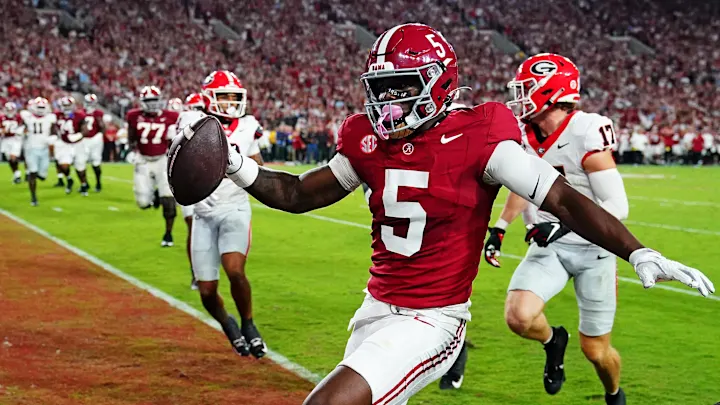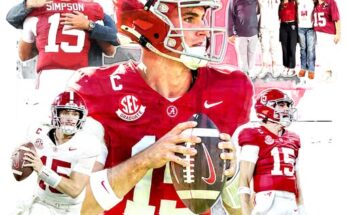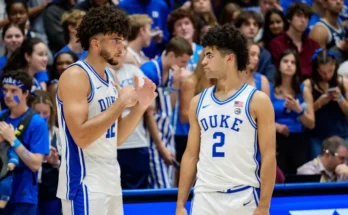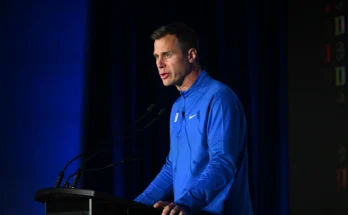‘No Doubt’ That Alabama’s Receiving Corps Could Be the Nation’s Best, Says Germie Bernard
When Germie Bernard transferred to Alabama from Michigan State, he did so with the understanding that he’d be joining a receiving room with as much talent and upside as any in the country. A few months later, the speedy junior wideout has seen enough to go on record: “There’s no doubt in my mind we have the best wide receiver room in the country.”
That’s no small claim. College football’s landscape is filled with electric pass-catchers—from Oregon and Ohio State to Texas and LSU—but Bernard is adamant Alabama’s group has the depth, the explosiveness, and the firepower to outshine them all in 2025. And as spring ball progresses under new head coach Kalen DeBoer, early signs suggest he might not be exaggerating.
A New Era in Tuscaloosa
Following the retirement of legendary head coach Nick Saban, many wondered if Alabama would experience a dip in dominance. But if there’s one thing DeBoer’s track record ensures, it’s high-level offensive production. His success at Washington—culminating in a national championship game appearance led by Heisman finalist quarterback Michael Penix Jr.—was built on a deep and explosive receiving corps.
Now at Alabama, DeBoer has inherited (and enhanced) a group of receivers tailor-made for his vertical attack. Leading the charge is Bernard, who followed DeBoer’s offensive coordinator Ryan Grubb to Tuscaloosa, bringing his versatile playstyle and familiarity with the system.
“When I first got here, it didn’t take long to see the talent that was already here,” Bernard said following a recent spring scrimmage. “Guys like Kendrick Law, Kobe Prentice, Jalen Hale—these dudes can go. And then you add in new guys like Ryan Williams? Man, we’re stacked.”
The Returners: Experienced, Hungry, and Explosive
At the core of Alabama’s receiving unit is a group of players who, despite limited numbers in 2024 due to quarterback inconsistency and conservative play-calling, have flashed elite traits.
Kobe Prentice, now entering his junior season, brings blazing speed and refined route-running. He’s proven to be dangerous in space and is looking to become a more complete receiver under the new staff.
Kendrick Law, a physical weapon at 6’0″, 205 pounds, is a Swiss-army knife with experience at receiver, running back, and special teams. Law is finally set to settle into a full-time receiving role, and spring practices have seen him routinely create separation and finish tough catches.
Jalen Hale, the sophomore breakout candidate, may have the highest ceiling of them all. At 6’1″, 190, with long strides and strong hands, Hale has earned rave reviews from coaches and teammates alike.
“We feed off each other,” Hale said. “It’s competitive, but it’s also brotherhood. We’re all pushing each other every day. Coach DeBoer tells us: If one of us eats, we all eat.”
The New Faces: Injecting More Firepower
Alabama’s 2025 recruiting class added major reinforcements to the wideout room, headlined by Ryan Williams, the five-star prodigy from Saraland, Alabama. Reclassified from the 2026 class, Williams is just 17 years old but already looks like a college-ready star.
“Ryan’s the truth,” Bernard said with a smile. “You don’t see many dudes his age walk in and make plays like that. He’s fearless.”
Williams has drawn comparisons to recent Alabama greats like DeVonta Smith and Jaylen Waddle—not just for his speed but his polished skill set and football IQ. He turned heads in the first spring scrimmage, scoring twice and making a leaping catch that had fans buzzing.
Also joining the fold is Caleb Odom, a 6’5″ hybrid receiver/tight end who offers a unique mismatch for defenders. His ability to stretch the field up the seam and box out smaller DBs gives Alabama a true red zone threat.
Add in transfers like Bernard himself, and it’s easy to see why there’s optimism. The former Michigan State standout has adapted quickly, using his knowledge of the system to help younger receivers transition into Grubb’s playbook.
“We’re teaching each other,” Bernard said. “I know the system, but these guys know the culture. Together, we’re building something special.”
The System That Unleashes Receivers
At Washington, Ryan Grubb’s offense led the nation in passing with Penix throwing to a trio of 1,000-yard receivers. The scheme prioritizes spacing, timing, and vertical threats—perfect for a team loaded with speed.
Now in Tuscaloosa, Grubb has the luxury of tailoring the playbook to even more explosive weapons.
“Coach Grubb is all about putting guys in position to succeed,” Kendrick Law explained. “He doesn’t just run plays—he builds plays around us. It’s different.”
In practices, Alabama’s tempo has increased. Concepts like four-verticals, mesh, and layered route trees have replaced the more traditional pro-style routes under Bill O’Brien and Tommy Rees. Quarterback Jalen Milroe is thriving under the new system as well, making quick reads and letting it fly.
“He’s confident,” Bernard said of Milroe. “That deep ball is something else. And with the guys we have? He’s going to let it rip.”
Leadership and Chemistry
A major factor behind Alabama’s receiver confidence isn’t just talent—it’s the chemistry developing inside the room.
According to players, film sessions have become competitive games. Who can call out the coverage first? Who can break down the DB’s leverage the quickest? They challenge each other, trash talk, and correct each other like seasoned vets.
“The bond we’ve got—man, it’s different,” Prentice said. “We’re not trying to be ‘the guy.’ We’re trying to be that group.”
Bernard’s arrival has added to that mix. As a newcomer with knowledge of the offense, he’s become a quiet leader—someone younger receivers gravitate toward. But he’s quick to give credit back.
“They welcomed me in. No ego, just work,” Bernard said. “This room reminds me of what I imagine the Waddle-Jeudy-Smitty days were like.”
National Respect Incoming?
The national media hasn’t caught on just yet. While Alabama is still a top-5 program, most preseason previews have focused on the coaching change, the offensive line, or Milroe’s development. Few have pointed to the receivers as the potential X-factor.
That might change soon.
“If we go out there and do what I know we can do,” Bernard said, “the whole country is gonna have to take notice. We’ve got NFL dudes all over this room.”
Indeed, Alabama could realistically have three to five receivers drafted in the next two years. Williams, Hale, Bernard, and Law all profile as future pros. And Odom, with another year of development, could join that conversation too.
Grubb and DeBoer aren’t shy about setting expectations.
“We’re not building for mediocrity,” Grubb said last week. “We’re building to lead the nation in offense. And that starts with our receivers.”
The Road Ahead
Of course, talk is cheap without results. Alabama’s offense will be tested early in 2025, with non-conference matchups and an SEC gauntlet that includes Georgia, LSU, and Tennessee. The receivers will need to prove they can win against elite secondaries, stay healthy, and remain selfless.
But the early returns are promising. The receivers are making plays. The quarterbacks are trusting them. And the coaching staff is putting them in positions to succeed.
Bernard summed it up best: “We’re not here to be decent. We’re here to dominate.”
It’s been years since Alabama had a receiving corps that evoked comparisons to the legendary 2019 group that featured Jerry Jeudy, Henry Ruggs III, DeVonta Smith, and Jaylen Waddle. But if Germie Bernard is right, 2025 might bring a return to that standard.
With a deep, versatile, and hungry group—paired with a proven offensive scheme and a quarterback with elite arm talent—the Crimson Tide’s receivers could very well be the engine that drives them back to national title contention.
There’s no doubt, indeed.



